~~ Original US Mint Medal ~~
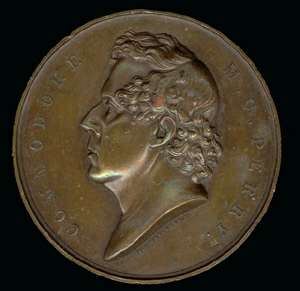
Click here for better view (front & back)
Distinguishing Characteristics
Original (this medal):
- Color: Mahogany/Dark Bronze
- Weight: 5 1/2 oz
- Diameter: 66 mm
- Rim/Edge: 5 mm
Early Restrke:
- Color: Dark Chocolate
- Weight: 6 1/2 oz
- Diameter: 66 mm
- Rim/Edge: 6 mm
Later Restrike (20th Century):
- Color: Yellow Bronze
- Weight: 6 ~ 6 1/2 oz
- Diameter: 66+ mm
- Rim/Edge: 4 mm
Front: COMMODORE M.C. PERRY.
Back (13 lines of inscription):
PRESENTED
TO COM. M.C. PERRY
SPECIAL MINISTER FROM THE
U.S.A.
BY MERCHANTS OF BOSTON.
IN TOKEN OF THEIR APPRECIATION
OF HIS SERVICES IN NEGOTIATING
THE TREATY WITH JAPAN
SIGNED AT YOKU-HAMA,
MARCH 31,
AND WITH LEW CHEW
AT NAPA, JULY 11,
1854.
.
Below the back inscription is MISSISSIPPI and above that the profiles of five ships.
The medal is bronze and 2 1/2 +/- inches in diameter and weighs 5+ to 6+ oz. The original medal was produced in gold, silver and bronze in 1856. I have recorded two distinct restrikes of the medal from c1891 to c1970.
To see the medal in honor of Commodore O.H. Perry (M.C. Perry's brother), click here.
There are a number of modern medals commemorating the Perry Expedition to Japan (Franklin Mint etc). However, there is one medal that is from the 19th century and it is seen on occasion. This medal is inscribed with the date 1854 but that relates to the treaties Commodore Perry signed. The original medals were struck in 1856.
This medal clearly is not a Congressionally authorized medal as was the one received by his brother, Commodore O. H. Perry. Congress never awarded a gold medal to Commodore M.C. Perry. He was, however, rewarded financially receiving a grant of $20,000 and 500 copies of the Narrative of the Expedition. Since the Narrative cost the Government $20.00 each to produce, these copies were valuable and sold for far more than the government cost on the open market.
A contemporary report regarding the medal was made by the merchants of Boston in an 1857 report which stated:
Perry Medal
It will be remembered that at a Special Meeting of the Board in January, 1855, a Committee was appointed to consider what notice the Board ought to take of the services of Commodore M. C. Perry, in the Special Mission to Japan; and that subsequently, upon the recommendation of that Committee, you directed that a gold Medal should be struck and presented to him; and that copies of the medal in silver should be presented to the principal officers of the expedition, and other copies in bronze to such other persons as were associated therewith in a manner to merit such distinction. In compliance with these directions, the Committee appointed by you have caused one gold, twenty silver, and sixty-three bronze medals to be struck from the same die, which have been presented to the parties for whom they were designed. (Third Annual Report of the Government, Presented to the Board at the Annual Meeting, on the 21st of January, 1857, By Issac C. Bates, Secy, Boston Board of Trade, Boston, George C. Rand & Avery, Printers, 1857 at pages 33-4)
Samuel E. Morison refers to this medal in his biography of Perry, Old Bruin. He states:
And the merchants of Boston struck for him a gold medal, his handsome profile on the obverse, and on the reverse an inscription thanking him for negotiating treaties of Kanagawa and Naha. Silver replicas were given to his officers and bronze ones to the men. (at page 417).
The medal has the engraver's name inscribed at the bottom of bust of Commodore Perry.

The inscription reads: "F. N. MITCHELL. F."
This medal is listed in Medals of the United States Mint, The First Century, 1792-1892 by R. W. Julian, edited by N. Neil Harris, 1977. It is listed as a "Personal Medal" and assigned the number PE-26. The catalogue notes that in 1856 the U.S. Mint struck one gold, twenty silver, and one hundred four bronze (copper-bronzed) medals and that the bronze medals were first sold to the public in October, 1861. The name of the engraver is given as "Francis N. Mitchell." While the catalogue listing of the medal does not mention later restrikes, that was a common practice and this medal was restruck. The catalogue lists the diameter as 63 mm but I find both the original and the early restrike measure 66 mm later restrikes are slightly larger (66~67 mm) than that. The author of the catalogue notes that many measurements were taken from pictures and "It is probably (sic) that many of the measurements will be one or two millimeters off for that reason alone." Regarding rarity and value, the author states that most of the medals struck at the mint prior to 1892 "...must be considered, at best, very scarce." No values are ascribed to any medals in the catalogue.
Market Value. The original medals rarely appear on the market, to include the bronze.
- Gold Medal (1 produced). On August 27, 2007 the original gold medal (with a deteriorated case) presented to Commodore Perry was sold at an auction conducted by Bruce Gamage in Rockland, Maine. The medal sold for $165,000 (including the buyer's commission).
- Silver Medal (20 produced). On January 18, 2008 a silver medal sold for $18,750 (including the buyer's commission) at Sotheby's, New York (lot 56). This medal was described as in "Good" condition and with a diameter of 66 mm.
An 1856 Original Silver Medal
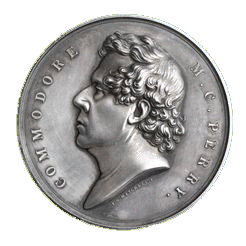
An 1856 Original Copper Bronzed (Mahogany) Medal
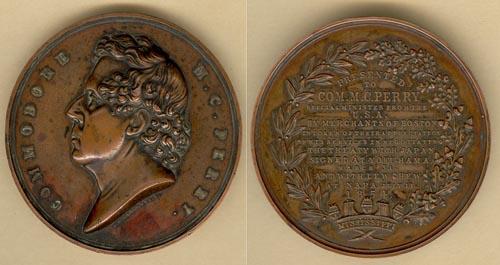
An Early Copper Bronzed (Dark Chocolate) Medal Restrike
Late 19th Century ~ Early 20th Century (c1891-c1916)
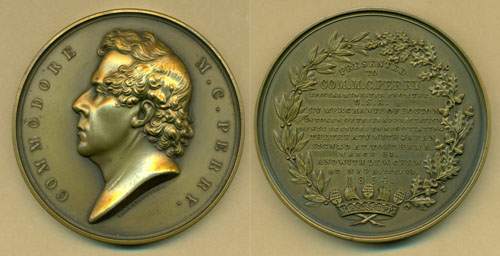
An Early Copper Bronzed (Dark Chocolate) Medal Restrike
Late 19th Century ~ Early 20th Century (c1891-c1916)
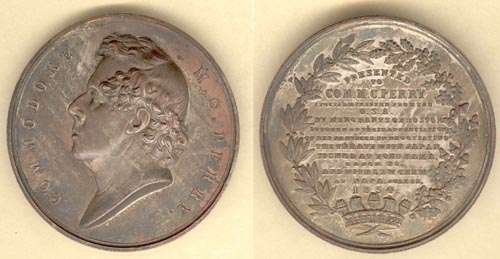
(Above medal had a silver wash applied, probably privately.)
A 20th Century Yellow Bronze Restrike (c1950s-1970s)
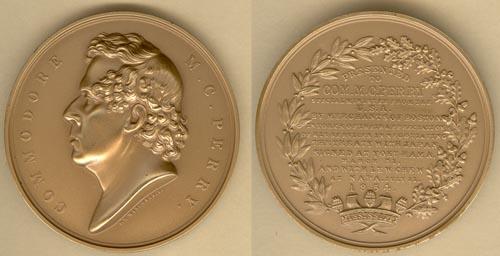
Distinguishing Between Originals and Restrikes.
- Surface & Color.
Original. The original copper-bronzed medals have what is referred to as a "mahogany" appearance. These medals were struck in copper and then chemically treated after striking. They have a proof (smooth) type surface and the color ranges from light reddish to dark brown. This type of bronze medal was produced at the Mint between 1825-1891. Clearly the original 104 bronze medals fall into this category.
Early Restrike. This medal is also copper-bronzed. It has a dull surface and the color ranges from light to dark brown ("dark chocolate"). This type of medal was known to have been produced by the US Mint between 1891 and 1916. I refer to these as the early restrikes.
The 20th Century Restrike. These are known as "true bronze" restrikes and they have a "yellow bronze" appearance. Since they are sandblasted in the manufacturing process, small pits caused by the blasting are visible under magnification. This process was first introduced in the US Mint in 1901-2. However, my research indicates that the vast majority of the PE-26, M.C. Perry, medals seen on the market are the recent 20th century restrikes from the c1950-c1970 period. To see side by side comparison of an original silver medal and the 20th century restrike, click here.
Below is a side by side comparison of an original and a modern "yellow bronze" restrike.
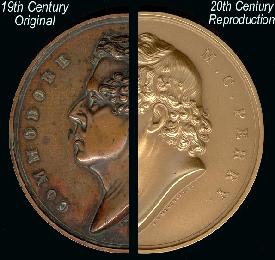
- Size (Diameter).
Original. 66 mm.
Early Restrike. 66 mm.
The 20th Century Restrike. 66~67 mm.
These medals are roughly 2 1/2 inches wide (actually 2 5/8 +/-) and often described that way.
- Weight.
Original. 5 1/2 oz (less than 6 oz)
Early Restrike. 5 1/2+ oz (less than 6 oz)
The 20th Century Restrike. 5.88 oz (166.5g) to 6.06 oz (172g)
I suspect the restrikes weighing over 6 oz were produced earlier than
those weighing slightly less than 6 oz. To see a 172g medal, click here.
The 172g medal shows clear banding/horizontal lines on the edge.
- Surface.
Original. The surface is smooth and glossy.
Early Restrike. The surface is dull and flat.
The 20th Century Restrike. Shinny, bright and reflects light strongly. Since these medals were sandblasted in the manufacturing process, small pits caused by the blasting are visible under magnification. Fine pitting is not seen on the earlier restrikes.
- Edge.
Original. 6 mm
Early Restrike. 6 mm
The 20th Century Restrikes. 3.5 ~ 5 mm
The edges (measured across the side from the outside of each rim) on the original medal and early restrike are noticeably wider than the 20th century restrike. On the original medal or the early restrike, when you place the medal face up (obverse up - Perry's image up), it is steady and does not rock when touched. When you do this with the restrike, it rocks/wobbles slightly when touched. All medals rock/wobble when placed face down and touched.
Below is an image of the edges of a early restrike and a 20th century restrike viewed side by side.
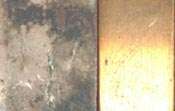
- Lip on the Edge.
Original. The lip is flat.
Early Restrike. Some, but not all have raised areas (ridges) on the inside and outside of the lip of the medal's edge (picture below). These ridges are not present on the entire lip. On the obverse, they are present primarily at the bottom below Perry's portrait. On the reverse they are present the entire circumference but very faint at the top.
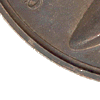
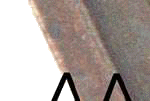
The 20th Century Restrike. The lip is flat and smooth.
By lip of the edge I am referring to the rim or the outermost edge of the medal.
- Curvature of the Background Area on the Front.
Original. The area surrounding Commodore Perry's portrait is flat.
Early Restrike. Same as the original, the area around the portrait is flat.
The 20th Century Restrike. The area around the portrait is convex and appears to raise slightly as it approaches the portrait. This is more pronounced on the more recent restrikes than others. The modern restrikes with a rim of 5mm and weighing 6oz/172g do not show the convex appearance.
- Engraving Characteristics on "Commodore" on the front of the medal and Perry's Hair.
Original. Several characteristics which appear to be constant, based on my limited research, can be observed on the lettering "COMMODORE" to the left of Perry's portrait and on a lock of hair at the top of his head. To see these distinctive characteristic, click here.
Early Restrike. Same engraving characteristics as found on the original.
The 20th Century Restrikes. These characteristics are not seen on the restrike.
- Overall Appearance. The original medal and the early restrikes appear to me to have slightly greater relief and detail. However, I am not able to point to a specific feature to illustrate this and it is just a general impression.
A Word of Caution. I have found nothing published regarding the original medals and restrikes. Frankly, this is a rather obscure area and doesn't appear to have been the subject any serious research. I have personally examined only 2 original medals, 1 early restrike and 10 or so modern restrikes. Weights were not take on a jeweler's scale. Please consider the above in this light. I do not consider my classification anywhere near definitive and perhaps additional information will contradict them.
Modern US Mint Marketing of Restrikes. The modern 20th century restrikes are seen on the market from time to time. It would be a mistake to presume that a dark color medal is an original. The dark color could result from normal or artificial processes. All factors above should be considered in evaluating a medal. As late as 1972 (probably even later) the US Mint was offering a restrike of this medal. It designated the medal No. 526 in the sales catalogue. I have seen a restrike in a mint box with the No. 429 and a price of $15.00. I presume this predates the restrikes marketed under No. 526. It appears to me that the lighter the medal and smaller the rim the more modern the manufacture. The mint described the size of the medal as 2 1/2 in. I do not believe the Mint is selling restrikes in recent years. These modern restrikes are occasionally found in the original small sealed plastic sack and white box (3.5 x 3.5 x .75 in) in which the Mint sold them.
Pattern of Distribution of the Original Medal. The medal was produced by the U.S. Mint on the request of the Merchants of Boston and probably followed the customary pattern of distribution for US Mint medals of this type. It was customary to give the person honored the gold medal. Silver medals would go to higher ranking individuals closely associated with the event commemorated. In this instance, the commissioned officers in command or higher positions on the Expedition to Japan probably got the 20 silver medals. The bronze medals (63 or 104) probably went to lower ranking officers and other key personnel and a small remainder sold to the public in 1861. The Expedition to Japan had over 190 Officers and Chief Petty officers. It is clear that not all officers of Petty Officers received medals but I suspect that many did. This was the system used regarding a similar type U.S. mint Congressional commemorative medal presented in 1818 to Commodore M. C. Perry's brother, Commodore O. H. Perry. William Elliot Griffis, however, seems to cast doubt on the distribution pattern for this medal. In his book,.Matthew Calbraith Perry (more information here), he states "Copies of the medal in silver and bronze were received by subscribers to the gold original." This implies that the distribution pattern for the medal was different, or at the least modified to some extent, to include providing silver and gold copies to the subscribers, the Merchants of Boston (See Griffis at page 446).
|










